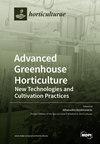Escherichia coli Inoculation Decreases the Photosynthetic Performance on Tomato Plants: Clarifying the Impact of Human Commensal Bacteria on Transient Plant Hosts
IF 3.1
3区 农林科学
Q1 HORTICULTURE
引用次数: 0
Abstract
The commensal/pathogenic Escherichia coli affects humans and animals, being present in diverse environmental niches, possibly surviving due to its adaptation to transient plant hosts like crops, increasing the risk of foodborne diseases. E. coli interaction with the plant host remains unknown, particularly the impacts on photosynthesis. We hypothesize that E. coli influences the tomato transient host’s photosynthetic capacity. To validate this hypothesis, we exposed 57-day-old tomato plants (Solanum lycopersicum) to different inoculation conditions, namely, non-inoculated plants (negative control, C−); plants directly injected with E. coli SL6.1 (107 CFU/mL) (positive control, C+); plants irrigated one time with E. coli SL6.1 (107 CFU/mL); and plants chronically irrigated with E. coli SL6.1 (104 CFU/mL). No significant changes were observed in chlorophyll fluorescence, pigments’ contents, morphological aspects, and fruiting in all conditions. However, irrigated plants (chronically and one-time contaminated) had decreased stomatal conductance (gs, 31.07 and 34.42 mol m−2 s−1, respectively, vs. 53.43 and 48.08 mol m−2 s−1 in C− and C+, respectively), transpiration rate (E, 0.32 and 0.35 mol m−2 s−1 in chronically and one-time contaminated conditions vs. 0.57 and 0.48 mol m−2 s−1 in C− and C+, respectively), and a trend of increased intrinsic carboxylation (Ci, 384 and 361 ppm in chronically and one-time irrigated plants vs. 321 and 313 ppm in C− and C+, respectively). The one-time inoculated plants presented more severe effects than the remaining conditions, with lower net photosynthetic rate (PN, 0.93 vs. 3.94–5.96 μmol (CO2) m−2 s−1 in the other conditions), intrinsic water use efficiency (iWUE, 33.1 vs. 74.51–184.40 μmol (CO2)/ mmol (H2O) in the chronically irrigated and the control plants), and intrinsic carboxylation efficiency (iCE, 0.003 vs. 0.012–0.022 μmol (CO2)/ppm in the remaining conditions). Our data support that some observed effects are similar to those associated with phytopathogenic bacteria. Lastly, we propose that the decrease in some parameters of gas exchange requires direct contact with the leaf/stomata, and is mainly observed for high concentrations of E. coli.大肠杆菌接种会降低番茄植株的光合作用性能:澄清人类共生细菌对植物短暂寄主的影响
共生/致病大肠杆菌影响人类和动物,存在于不同的环境中,可能由于适应农作物等短暂的植物宿主而存活下来,增加了食源性疾病的风险。大肠杆菌与植物宿主之间的相互作用,尤其是对光合作用的影响仍是未知数。我们假设大肠杆菌会影响番茄短暂寄主的光合作用能力。为了验证这一假设,我们将 57 天大的番茄植株(Solanum lycopersicum)置于不同的接种条件下,即未接种植株(阴性对照,C-);直接注射大肠杆菌 SL6.1(107 CFU/mL)的植株(阳性对照,C+);用大肠杆菌 SL6.1(107 CFU/mL)灌溉一次的植株;以及用大肠杆菌 SL6.1(104 CFU/mL)长期灌溉的植株。在所有条件下,叶绿素荧光、色素含量、形态特征和结实情况均无明显变化。然而,灌溉植物(长期污染和一次性污染)的气孔导度(gs,分别为 31.07 和 34.42 mol m-2 s-1,而 C- 和 C+ 条件下分别为 53.43 和 48.08 mol m-2 s-1)、蒸腾速率(E,分别为 0.32 和 0.35 mol m-2 s-1,而 C- 和 C+ 条件下分别为 0.32 和 0.在长期和一次性污染条件下分别为 0.32 和 0.35 mol m-2 s-1 ,而在 C- 和 C+ 条件下分别为 0.57 和 0.48 mol m-2 s-1),以及内在羧化增加的趋势(在长期和一次性灌溉条件下分别为 384 和 361 ppm,而在 C- 和 C+ 条件下分别为 321 和 313 ppm)。与其他条件相比,一次性接种的植物受到的影响更严重,净光合速率(PN,0.93 vs. 其他条件下的 3.94-5.96 μmol (CO2) m-2 s-1)、内在水分利用效率(iWUE,33.与长期灌溉和对照植物的 74.51-184.40 μmol (CO2)/ mmol (H2O)相比),以及内在羧化效率(iCE,0.003 与其他条件下的 0.012-0.022 μmol (CO2)/ppm)。我们的数据表明,观察到的某些效应与植物病原菌的效应类似。最后,我们认为气体交换的某些参数的降低需要与叶片/气孔直接接触,而且主要是在高浓度大肠杆菌的情况下观察到的。
本文章由计算机程序翻译,如有差异,请以英文原文为准。
求助全文
约1分钟内获得全文
求助全文

 求助内容:
求助内容: 应助结果提醒方式:
应助结果提醒方式:


